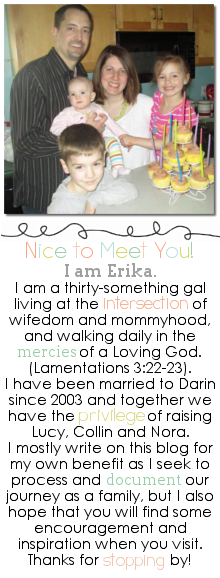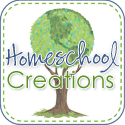This is just a smattering of materials and activities that I do with Lucy and Collin to supplement their main math curriculum (they both do kindergarten level math at this point). They seem to genuinely ENJOY these activities, and if we can tackle math in an enjoyable and playful manner, then all the better in my opinion!
1. Inchimals by Fat Brain Toys
We LOVE Inchimals! This is a set of 12 beautiful wooden blocks, ranging in length from 1" to 12". Each block is represented by a different animal, and includes the inch markings on the sides. Not only do my kids love using their inchimals to measure things all over the house, but they love using them to solve the math equations included in the spiral-bound dry erase book included with the set. The math equations are presented using the animals that are assigned to the blocks. Below is an example of a simple addition equation that Lucy solved by finding the "lady bug" and "mouse" blocks. One she determined the length of each block and wrote their numerical value below, she was ready to add the two pieces together and then search for the inchimal that was equal to the sum of the two original blocks. In this case, she figured out that "mouse" + "lady bug" = "rabbit" or 4". As your children work their way through the book they'll encounter subtraction and more complex equations to solve. I love that they can grow along with it!
2. Do A Dot Art Markers, Ready 2 Learn Giant Number Stamps, and Ready 2 Learn Giant Math Signs Stamps
I snagged these jumbo number and math sign "Ready 2 Learn" brand stamps from Zulily sometime ago, and we are sure putting them to great use! The number set includes stamps for numerals 0 through 9 and the math signs set comes with stamps for addition, subtraction, multiplication, division, greater than and less than and equals signs. My kids love it when I pull out our giant ink pads, construction paper, giant stamps and our Do A Dot markers! They get to pick out the color of paper, color of ink, and number stamps (which they truly find thrilling!) and with my guidance, stamp out an equation at the top of their paper. If we work with addition, then they use the Do A Dot markers to stamp out the number of dots indicated by their chosen numbers and solve the equation visually. When doing subtraction, they stamp out dots representing the larger number and then use little squares of paper to cover up the dots corresponding to the second number in their equation. My craft-loving kids just love the process and feel so pleased when they solve their equations. It may seem like a lot of trouble to go to for a couple of math equations, but their delight in the activity makes it worth it for me.
3. Eeboo Preschool Lotto Game and Mr. Printable's Simple Printable Numbers
During Lucy and Collin's preschool days, our family spent a lot of time playing the delightful Preschool Lotto Game together! Now they go for games that are a little more complicated during free time, but we have found ways to breath new life into this game by incorporating it into subtraction lessons!
I printed off and cut out several sets of these simple number cards from the Mr. Printables website and keep them tucked inside the game box. To play the game, each player takes their own game board which has six illustrations on it arranged in a grid. Players take turns drawing tiles from the center of the play area and matching the tiles to the identical illustrations on the board. The first player to fill their game board wins.
To turn this game into a subtraction lesson, the kids and I play until everyone has filled their game board. Then I have each kid find a number 6 card, representing the total number of illustrations on their board and a subtraction sign card (which is included in the set).
Then I call out a color, and each kid looks at their board and removes from their board every tile that has that color in it. Once they have removed and counted those tiles, they find the corresponding number card and arrange it with the other cards the found before and create a subtraction equation to solve. Then it is simply a matter of them counting their remaining tiles on their board to identify the difference.
We normally refill their board with all the tiles and call out more colors several times to work in as many subtraction equations as they have the attention for. Obviously the lesson is a bit limited by the fact that the highest number we are subtracting from is 6, but I found it to be a good introduction to the concept of subtraction.
It is pretty hard to teach kiddos the concept of measurement without giving them something tangible that invites them to personally explore it. The Primary Bucket Balance and Centimeter Cubes make it easy to introduce the ideas of measuring mass using items found around the house.
Sometimes I will take a basket and fill it up with small household objects. Then I present the items to the kids along with the bucket balance and tub of plastic centimeter cubes and have them discover how many centimeter cubes are equal in mass to each object. They are instructed write down the number of cubes for each object and once they find the number for each object they then arrange the items in order from least to greatest. It is also fun to have them guess the answer before they take the measurement and see them experience delight when their guess was close, or wonder to learn that their item had much more or less mass than they guessed.
Of course there are so many more things you can do with these items! This little activity is just one way we enjoy them. It is also pretty great just to put these items in the kids' hands and see what they come up with on their own.
5. Kathy Troxel Addition Songs and Subtraction Songs (with addition and subtraction flash cards)
For the most part in our home schooling efforts, I emphasize foundational mathematical concepts over memorizing rote facts. But, memorization definitely has its place in our curriculum and when I do introduce memorization tasks I try to make them as pleasant as possible! Kathy Troxel's music has made these efforts seem effortLESS!
To make the most of the memorizing attempts I wanted to pair these songs with flash cards so there would be a visual and auditory component. I looked for the most simple addition and subtraction flash cards I could find and ended up with these by Trend Enterprises:


We are slowly downloading our way through Kathy Troxel's Addition Songs and Subtraction Songs albums. I simply stack the flash cards in order before playing a song with the kids and we sing along and flip through the cards together. Pretty simple but my kids seem to enjoy it and haven't protested once when I pulled the cards out and played the music.
6. Dot to Dot Books
Often I find that when I am doing school with my kids one of them is needing individual attention while another is left without much to do. It is nice to be able to point them toward something that they can enjoy and do independently! When I want to point them towards something that will reinforce math-learning I frequently gravitate towards dot-to-dot pages. It seems like such a simple suggestion, but my kids rarely tire of them and I like the way they help them in recognizing and putting ordinal numbers together from least to greatest.
If you are wanting to invest in some supplemental early learning math materials for your kiddos, I sincerely hope this has given you some ideas that will be helpful! Do your kids have some favorite math activities? Please tell me about them! I am always on the look out for fresh ideas!
xoxo,







.JPG)













I love those inchimals! I was just looking into math concept music. thanks for sharing these great tips on the Love to Learn hop! ~SandyToesCreations
ReplyDelete